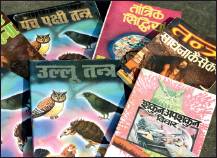Owls: India
This is a collection of articles archived for the excellence of their content. |
Contents |
Exploitation
2016: The Diwali sacrifice/ Delhi
The Hindu, October 29, 2016
Bindu Shajan Perappadan
Days away from one of the most anticipated festivals, countless owls face a cruel fate at the hands of poachers who are catering to ignorance and misguided beliefs.
The Festival of Lights casts a dark shadow over the lives of thousands of owls that fall victim to human exploitation. Driven by religious myths and superstitious beliefs, these birds are poached for their talons, skulls, bones, feathers, meat and blood, which are then used in talismans, black magic and traditional medicine.
Based on a centuries old belief, owls are sacrificed during Diwali to appease Lakshmi, the goddess of wealth and prosperity. Some people believe that by sacrificing her ‘vaahan’, the goddess is compelled to remain in their homes, thereby bringing them good luck and wealth all year round.
The exact number of owls traded and sacrificed each year is unknown.
Geeta Seshamani, co-founder of Wildlife SOS said: “Such blind faith has led to exploitation of this unique wildlife species.Awareness regarding the illegality of the offence and the abominable treatment of these birds is incredibly important to curb cruelty and poaching of wildlife.”
According to some reports, the Indian (Rock) eagle owl, brown fish owl, dusky-eagle owl, Indian scops owl and mottled wood owl are five of the most traded owl species in the illegal market. Horned owls such as the Indian eagle owl are especially coveted for their false feather ear tufts (feather extensions on the head), which are considered to have mystical properties.
The bird markets in Chandni Chowk and Jama Masjid are among the many places within New Delhi that cater to the huge demand for these protected and rare owl species during this festive season. Their wings are trimmed and the birds are crammed into tiny cages, forced to live in horrific conditions.
“Revered in Indian mythology and culture, it is quite ironic to see these very birds being treated as sacrificial offerings and commodities,” said Kartick Satyanarayan, co-founder of Wildlife SOS and head of the organisation’s Anti-Poaching Unit, Forest Watch.
Many people sacrifice owls during Diwali believing that it will bring them good luck and prosperity
2018: the Baheliyas in Meerut, Nainital/ Uttarakhand

From: Sandeep Rai & Vineet Upadhyay, In Red List of threatened species, owls massacred on Diwali, October 28, 2018: The Times of India
Killed in tantrik rituals for prosperity, birds sell for upto Rs 50k a piece
In the Lal Kurti area of Meerut city, members of the Baheliya community are busy. Working in small groups, they handle individual, sometimes pairs of owls brought in by trappers and poachers from the region and the hills of Uttarakhand. Diwali is less than a fortnight away, and the birds are in great demand.
They might be feared raptors of the night, but for the owls of India, the Diwali season holds deadly peril. The bird, because of its status as vehicle of the goddess of wealth Lakshmi, is sought for sacrifice in tantrik rituals during Diwali, which many feel bring prosperity and good fortune. A countrywide smuggling trade in owls is rampant during this season. So are the killings.
“There are 30 owl species in India and most of them are in the Red List of threatened or endangered species of the International Union for Conservation of Nature (IUCN) and Schedule I of the Wildlife Protection Act. There is a sharp spike in their capture and trade during the Diwali season. The birds are subjected to brutal deaths through black magic rituals,” said Abrar Ahmad, an ornithologist who has been following the illegal bird trade.
The exact number of the birds trapped and killed each year has not yet been estimated. But it’s “large”. Amhad said: “Tribes like the Baheliyas are involved in trapping them in areas from Pilibhit, Meerut, Moradabad and Agra to Dehradun and Ambala. There are at least 16 tribes in India involved in the trade.”
The most common way of trapping owls is the latex and bamboo method. A latex-glue smeared twig is fitted onto one end of a long bamboo stick and is slowly moved towards the roosting owl perched on trees during daytime. The bird gets stuck to the twig and is pulled down. Then there is the ‘takkva’ method in which a long needle is thrust at the bird, frequently killing it.
The captured birds face a worse fate. “Every part of an owl’s body has significance in sorcery and black magic. A live owl buried during Diwali outside the door of a house is supposed to bring prosperity. In one of the rituals, the bird is even blinded before it is slowly killed over days.The tantriks are the real culprits,” Ahmed added.
“There is a lot of demand for owls in this season at bird markets here and elsewhere. Those who want owls, including tantriks, know where to ask. We just capture the birds. It is the tantriks who kill them,” said Manohar Baheliya, who is involved in the trade in Moradabad.
The price of an owl ranges from Rs 300 to Rs 50,000 for larger species. The most prized are the rock eagle owl, dusky eagle owl and brown fish owl.
Lalit Verma, forest conservator, western zone, Uttar Pradesh, told TOI, “We have told DFOs in the zone to be on the alert and have deployed our men at bird markets. Rangers are also on the alert in forests.”
Parag Madhukar Dha-kate, forest conservator, western circle, Kumaon region of Uttarakhand, said the police department was assisting the forest department in trying to curb the trade during Diwali.
